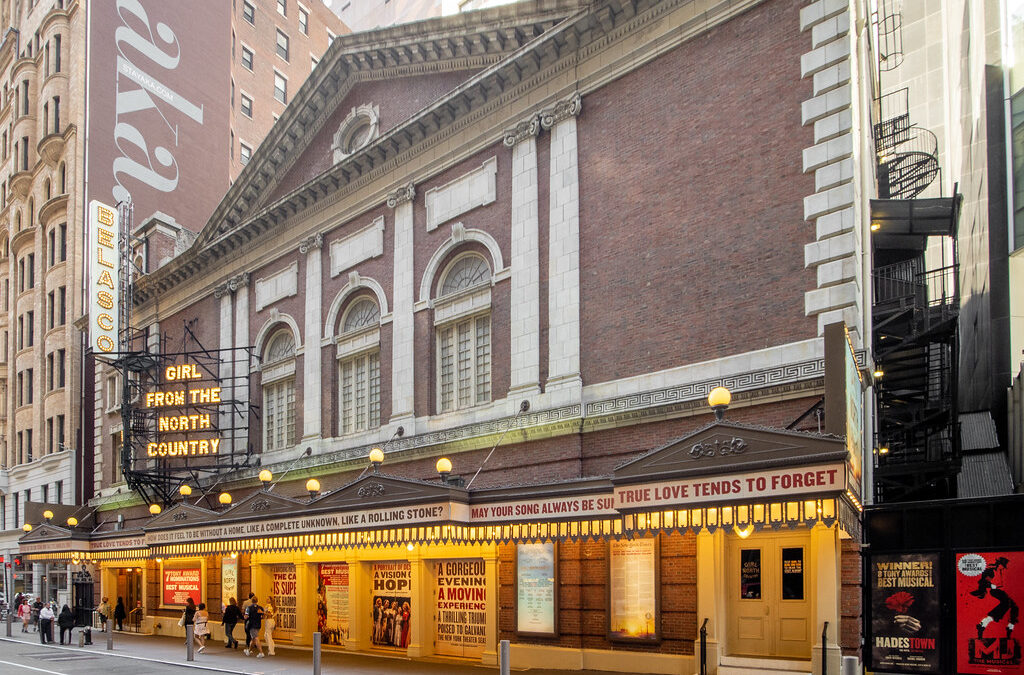New York City is home to dozens of theater venues divided into three categories: Broadway, off-Broadway, and off-off Broadway. To be officially classified as a Broadway theater, a venue must have at least 500 seats and be located in Manhattan between 6th and 8th Avenues and 41st and 54th Street, with the exception of the Vivian Beaumont Theater at the Lincoln Center on West 65th Street. There are 41 Broadway venues, including the Lyric Theatre, Nederlander Theatre, Gershwin Theatre, and American Airlines Theatre.
Some of these venues, including the American Airlines Theatre, have been in existence under a variety of names for more than 100 years and have featured some of the most prominent productions and popular performers. Below is a closer look at the history of the American Airlines Theatre, located at 227 West 42nd Street.
1. It Was Designed by George Keister
The American Airlines Theatre opened in 1918 as the Selwyn Theatre in recognition of its producers Arch and Edgar Selwyn. It was designed by acclaimed American architect George Keister. Born in Iowa in 1895, Keister already had a reputation for designing entertainment venues by 1918. His prior work included the Astor Theatre (1906), Belasco Theatre (1907), Bronx Opera House (1913), and the Apollo Theater (1914).
Keister designed the 1,051-seat venue in the Italian Renaissance style with two levels of box seats, a gold and blue color theme, and large murals covering the walls. The Selwyn’s opening production, Information Please, starred playwright and actress Jane Cowl, known for playing Juliet in Shakespeare’s Romeo and Juliet. Unfortunately, the production was a critical and commercial flop that lasted just 46 performances.
In addition to prompting audience members to buy Liberty Bonds, the opening night program included the following: “Every German or Austrian in the United States, unless known by years of association to be absolutely loyal, should be treated as a potential spy. Keep your eyes and ears open. Whenever any suspicious act or disloyal word comes to your notice, communicate at once with the Bureau of Investigation of the Department of Justice, 15 Park Row, New York. We are at war with the most merciless and inhumane nation in the world.”
2. Its Early Productions Featured Both Successes and Flops
The Selwyn’s next production, which also starred Cowl, was much more successful. The Crowded Hour, written by Edgar Selwyn and Channing Pollock, had a run of more than 120 performances. Buddies, however, was the Selwyn’s first massive hit.
George V. Hobart’s World War I musical, set in Normandy not long after the Armistice, involves a shy American who falls for a French woman who, despite sharing his feelings, flirts with his friend to capture his attention. The musical ran for 259 performances and critics were especially impressed with its three leads: Roland Young, Peggy Wood, and Donald Brian.
The Selwyn had a mix of critical successes and flops during the 1920s. The Blue Kitten (1922), Helen of Troy, New York (1923), Battling Butler (1923), and The Royal Family (1927) were among its most notable productions. The latter play, written by George S. Kaufman and Edna Farber, was believed to be a parody on two of theater’s most esteemed dynasties at the time, the Drew and the Barrymore families. The comedy ran for 345 shows and has been revived multiple times, most recently in 2009.
In addition to showing original plays and musicals, Selwyn debuted several popular British revues in the 1920s, including Noël Coward’s This Year of Grace (1928) and Wake Up and Dream (1929).
3. It Was Converted to a Movie Theater in 1934
Like many venues, the Selwyn faced serious financial troubles during the Depression. It showed 11 consecutive flops and, by 1934, Arch had filed for bankruptcy and new owners took the theater in a new direction, showing films instead of live performances. Apart from a failed experiment in the 1950s, when the theater combined live drama with film components, it was exclusively a movie theater for more than 50 years.
4. It Was Restored in 2000
In the 1990s, an organization known as the New 42nd Street sought to redevelop the area where the Selwyn was. At the time, the nonprofit Roundabout Theatre Company was temporarily operating out of the Criterion Center in Times Square. The Company decided to purchase and restore the venue while recommitting to its original dedication to showing quality live theater. The restoration project cost $25 million, $8.5 of which was provided by American Airlines for naming rights.
As part of restoration efforts, the number of seats in the venue were reduced to 750 to provide a more intimate setting with expanded leg room and better acoustics.
5. Productions in the 21st Century
The newly branded American Airlines Theatre opened on July 27, 2000, with a showing of The Man Who Came to Dinner, a revival of Kaufman and Moss Hart’s 1939 comedy. A subscription house, the theater predominantly scheduled plays and musicals as limited runs in the 2000s, meaning it usually presented anywhere from two to five performances each year. Some, including The Pajama Game and Twelve Angry Men, lasted longer than 100 performances.
The theater has housed several Tony-nominated productions in the 21st century, including Big River (2003), Twelve Angry Men (2004), and The Constant Wife (2005). It also showed the Broadway debut of the Pulitzer Prize-winning A Soldier’s Play (2020). Recent productions include Fat Ham (2023) and 1776 (2023).
6. Now Playing
From October 13 to December 23, the American Airlines Theatre is showing I Need That, a comedy starring Danny DeVito as a reclusive hoarder facing eviction unless he cleans his place. It is scheduled to show Home, a Tony-nominated coming-of-age drama, from May 17 to July 28, 2024.

